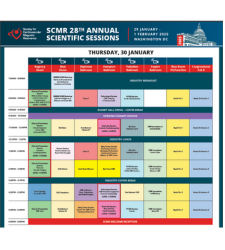Rapid Fire Abstracts
Rapid Fire 07- Clinical Outcome and Prognosis II
Feasibility, safety and prognostic value of stress cardiac MRI in end-stage renal disease patients. (RF_FR_363)
Friday, January 31, 2025
1:50 PM - 2:00 PM East Coast USA Time
Location: Blue Room PreFunction
- IR
Iyad RIFAI, MD
Resident
Pitié-Salpêtrière Hospital, France - IR
Iyad RIFAI, MD
Resident
Pitié-Salpêtrière Hospital, France .jpg)
Alban Redheuil, MD PhD
MD, PhD
Assistance Publique – Hôpitaux de Paris, France
Presenting Author(s)
Primary Author(s)
Co-Author(s)
Background: Patients with end stage renal disease are at high risk of cardiovascular events. Contrast-enhanced stress CMR appears to be one of the most effective and safe modalities with high prognostic value in patients with early stage of CKD. Its safety and prognostic value in end stage renal disease (ESRD) is not established due to the potential risk of nephrogenic systemic fibrosis (NSF). We aimed to assess the safety and the incremental prognostic value of contrast-enhanced stress perfusion CMR in asymptomatic ESRD patients undergoing cardiac assessment before kidney transplantation (KT).
Methods: Between 2008 and 2022, we conducted a retrospective monocenter study with all consecutive asymptomatic patients with ESRD, defined by estimated glomerular filtration rate (eGFR) < 30 ml/ min/1.73 m2 or under dialysis, and referred for stress CMR. Patients with prior or foregoing heart transplant were excluded. All patients were followed for the occurrence of major adverse cardiovascular events (MACE) defined as cardiovascular death, sustained ventricular arrhythmia, nonfatal myocardial infarction, late coronary revascularization and hospitalization for heart failure. Cox regression analysis was used to determine the prognostic value of stress CMR parameters, integrating the notion of noninfarct-related patterns, a specific sign of uremic cardiomyopathy.
Results: Of 2904 ESRD patients on waitlist for KT, 845 (58.8 ± 9.9 years, 67% men) constituted the study population. The median follow‐up was 5.4 [3.0–7.8] years. The safety profile of stress CMR was excellent without occurrence of NSF or severe adverse event related to the injection of gadolinium. The presence of abnormal perfusion and LGE were associated with the occurrence of MACE (HR 7.18 [5.15–10.0] and HR 6.63 [4.79–9.20] respectively, both p < 0.001). In multivariable analysis, abnormal perfusion and LGE were independent predictors of MACE (aHR 4.76 [3.34-6.79] and aHR 3.86 [2.59-5.74] respectively, both p < 0.001). Infarct and noninfarct patterns were also both independent predictors of MACE (aHR 5.68 [3.39-9.52] and aHR 5.84 [3.82-8.91] respectively, both p < 0.001). Stress CMR findings showed an incremental prognostic value above AHA2012 risk factors (C‐statistic improvement: 0.10; NRI=0.110; IDI=0.126).
Conclusion: In ESRD patients, stress CMR is feasible, safe, and its findings have an incremental prognostic value to predict MACE over traditional risk factors, by characterizing both ischemic heart disease and uremic cardiomyopathy.
Methods: Between 2008 and 2022, we conducted a retrospective monocenter study with all consecutive asymptomatic patients with ESRD, defined by estimated glomerular filtration rate (eGFR) < 30 ml/ min/1.73 m2 or under dialysis, and referred for stress CMR. Patients with prior or foregoing heart transplant were excluded. All patients were followed for the occurrence of major adverse cardiovascular events (MACE) defined as cardiovascular death, sustained ventricular arrhythmia, nonfatal myocardial infarction, late coronary revascularization and hospitalization for heart failure. Cox regression analysis was used to determine the prognostic value of stress CMR parameters, integrating the notion of noninfarct-related patterns, a specific sign of uremic cardiomyopathy.
Results: Of 2904 ESRD patients on waitlist for KT, 845 (58.8 ± 9.9 years, 67% men) constituted the study population. The median follow‐up was 5.4 [3.0–7.8] years. The safety profile of stress CMR was excellent without occurrence of NSF or severe adverse event related to the injection of gadolinium. The presence of abnormal perfusion and LGE were associated with the occurrence of MACE (HR 7.18 [5.15–10.0] and HR 6.63 [4.79–9.20] respectively, both p < 0.001). In multivariable analysis, abnormal perfusion and LGE were independent predictors of MACE (aHR 4.76 [3.34-6.79] and aHR 3.86 [2.59-5.74] respectively, both p < 0.001). Infarct and noninfarct patterns were also both independent predictors of MACE (aHR 5.68 [3.39-9.52] and aHR 5.84 [3.82-8.91] respectively, both p < 0.001). Stress CMR findings showed an incremental prognostic value above AHA2012 risk factors (C‐statistic improvement: 0.10; NRI=0.110; IDI=0.126).
Conclusion: In ESRD patients, stress CMR is feasible, safe, and its findings have an incremental prognostic value to predict MACE over traditional risk factors, by characterizing both ischemic heart disease and uremic cardiomyopathy.

